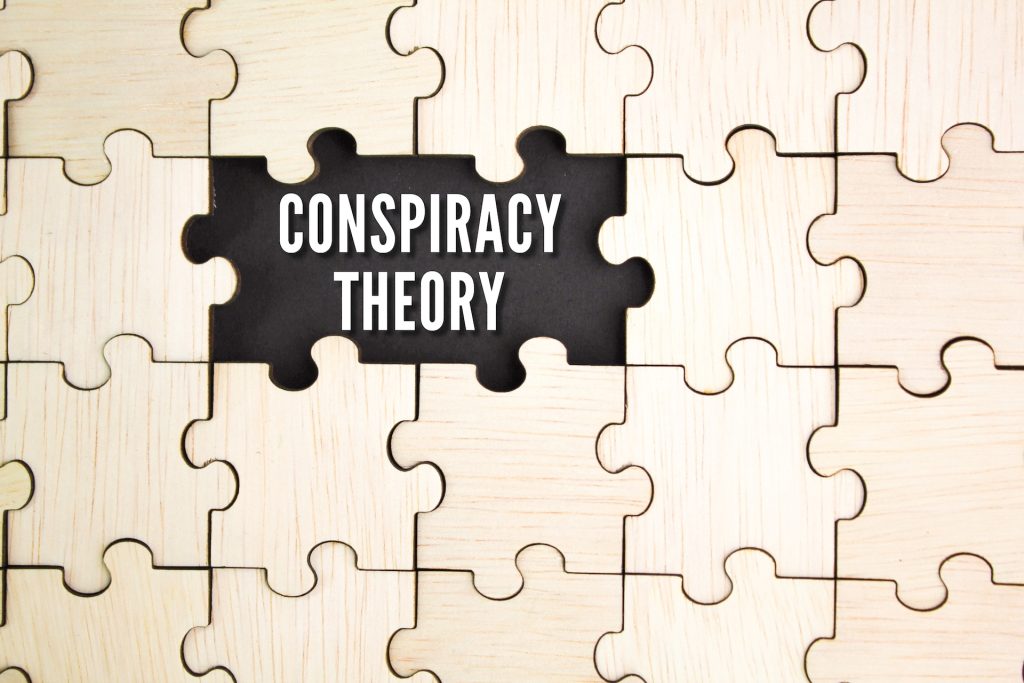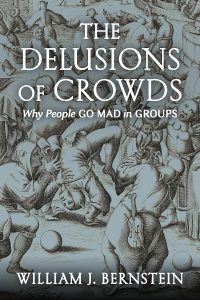Beware the Deception: How to Tell Conspiracy Theories and Paranoid Delusions Apart
Pizzagate, QAnon, Anti-Vaxers, Deep State, and Stolen Elections are just some of the best-known conspiracy theories today. Taken at face value, each professes a set of debunked beliefs that many have thought of as delusional. Conspiracy theories are neither new nor rare.
In his 2021 book The Delusions of Crowds, William J. Bernstein chronicled the history of why people go mad in crowds.
We are the apes who tell stories, and no matter how misleading the narrative, if it is compelling enough it will nearly always trump the facts. ~ William J. Bernstein
Bernstein traced the biological, evolutionary, and psychosocial underpinnings of irrational belief that gave rise to periods of past periods of religious, political, and financial madness. Thus, history shows us that widespread irrational beliefs can burn through communities like wildfire.
Conspiratorial beliefs are also surprisingly common. In the US, 20 to almost 50% of adults have held conspiratorial beliefs about the following events (Source: Statista):
- Lee Harvey Oswald didn’t act alone in assassinating JFK (47%)
- Search engines discriminate against conservatives (30%)
- There is a secret and powerful deep state working against former US president, Donald Trump, and his supporters (29%)
- The government is hiding aliens in Area 51 (27%)
- 911 was an inside job (23%)
- Climate change is a hoax (22%)
- The CIA created HIV to reduce the number of homosexuals and Black Americans (15%). HIV-related conspiracy theories are as high as 60% in HIV-positive Black Americans, which is believed to be rooted in historical experiences and healthcare disparities that sowed the seeds of medical mistrust.
Conspiracy theories seem to be everywhere, but have they really increased over time? Surprisingly, studies have shown a remarkable stability of conspiratorial beliefs over time.
Conspiracy Theories and Paranoid Delusions. Basic Similarities
Many have wondered whether such extreme beliefs represent delusional thinking. As a symptom of psychosis, delusions are false beliefs about external reality that are held in the presence of incontrovertible evidence that they are not true. What makes delusions symptomatic of a psychotic state is that they cannot be proven false. Oftentimes, efforts to point out the falseness of a delusion become incorporated into the delusional belief.
The conspiratorial belief that Democrats linked to Hillary Clinton in 2016 were running a child-sex ring from the basement of the Comet Ping Pong Pizza Restaurant in Washington, DC, sounded so bizarre as to be regarded frankly delusional. What else could explain this and the proliferation of similar-sounding extreme political beliefs?
However, before foreclosing too quickly and tossing around clinical terminology and labeling people whose beliefs we find extreme to be “crazy,” it’s worth looking at beliefs in conspiracy theories, commonly referred to as BCT, and determining whether they are examples of delusional thinking or whether they represent something else.
On the surface, BCT and delusions involve an unshakable conviction that a situation or situations one considers wrong or unjust are the result of a deliberate conspiracy of people with malevolent intentions. Believing the FBI is tapping your phone and plotting against you or that a web of sinister government bureaucrats and politicians have formed a network deep within the state share core beliefs that dark forces lie at the root of one’s problems as individuals or society writ large.
Both are essentially explanations to increase one’s certainty by constructing a causal explanation for one’s symptoms (in the case of delusional thinking) and for unwelcome trends in society (as with BCT). In both cases, individuals construct an alternative reality comprised of alternative facts that fit their theories.
What Are the Basic Differences?
Beliefs in conspiracy theories are fundamentally social phenomena, whereas delusions are essentially personal in nature. In conspiracy theories, the group is targeted; in delusions, it is the individual who is the target of malevolent actions by an external agency.
Although both conspiracy theories and delusions provide explanations––“Okay, this explains everything!”–– simplify complexity, increase a sense of control––“I know what’s really going now”––and reduce uncertainty, belief in conspiracies also meet epistemic, existential, and social needs. They provide clarity in uncertain times and social connections with an in-group of like-minded people.

The Truth Is Out There
In contrast to the social nature of conspiracy theories, those with paranoid delusions feel targeted as individuals or special, in the case of delusions of grandiosity. Folie a Deux is a delusion shared by two people, but generally, delusions are a solitary and isolating phenomenon. Furthermore, in delusions, the individual may feel that their inner self, reality, or relationships have been altered.
BCT, on the other hand, may bring subgroups of people together. Thus, they are generally social in nature. Conspiratorial beliefs may involve a sense of moral superiority, provide social support, and can be extremely compelling. As the 1990s hit The X Files made clear, belief in sinister forces shrouded in secrecy, pulling the levers of power behind the curtains can be enormously appealing alternatives to banal explanations offered by the establishment.
Distinguishing Conspiracy Theories from Delusional Disorders
A leading authority in the study of conspiracy theories, Joseph Pierre MD, said a couple of questions are necessary to tell them apart.
First, what is the evidence for the belief? Individuals who gravitate toward conspiratorial beliefs seek explanations from secondary sources, primarily the internet. Such individuals are not theorizing, per se, but adopting narratives that already exist. The “proof” exists, or as they often said on The X Files, “The truth is out there.” In contrast, psychotic individuals typically develop delusions from anomalous internal experiences based on personalized, idiosyncratic interpretations of external events.
The second question is whether the belief is self-referential. Once again, conspiracy theories are social phenomena; delusions are typically not. Furthermore, the delusional person is at the center of their delusional experience. In contrast, conspiracy theories involve a larger subgroup. Pierre cites the example of the Second Coming, which is shared by a large number of people. In contrast, it is much harder to convince others that you are the Second Coming.
Mental health professionals may be called upon to make the distinction between what is a conspiracy theory and what is a delusion. Dr.Mark Cunningham has written extensively about making this differential diagnosis, including developing an instrument to distinguish between delusional disorder and radicalization of extreme beliefs.
Two Components of Conspiracy Theories
Pierre has proposed a two-component model to account for the frequency of conspiracy theories. The core factor is epistemic mistrust, the distrust in established educational, legal, medical, scientific, or governmental authority. This can be conceived as a sociocultural response to broken trust, power inequities, and negative forces like racism.
In each case, the experts are not trusted. This is akin to informational anarchy, where the established epistemological order of things is rejected. The resulting vacuum is flooded by “alternative facts,” sending individuals “down the rabbit hole” to search for answers.
The second component has to do with what Pierre calls “misinformation processing,” which includes deep searches down the rabbit hole whereby individuals are always able to find information, no matter how much it has been disproved, to confirm their beliefs.
Conspiracy believers engage in numerous cognitive errors that support their original beliefs. Like the delusional individual, they are always able to find confirmation for what they believe in.
Helping Those Who Fall Prey to Conspiracy Theories
Individuals whose lives are consumed by their conspiratorial beliefs may be drawn into cult-like systems that are difficult for the individual to disengage from. Some general principles for helping friends and family members include:
- Learn about the conspiracy theories, their origins, central tenets, and the nature of their proofs. Knowledge is a powerful way to deal with the helplessness you may feel when speaking with a significant other whose life has been consumed by their conspiratorial beliefs.
- Don’t try to convince the individual that their conspiratorial beliefs are wrong. This won’t work. It ignores the underlying motivations that drove the person toward the conspiracy theory in the first place. Were they feeling lonely, disempowered, and unimportant? If so, believing a conspiracy theory may fill those needs, which can’t simply be argued away.As is the case with delusions, efforts to debunk the person’s reality may backfire and instead create further distance between you and them, possibly resulting in your being drawn into the core conspiracy.
- Encourage critical thinking by asking open-ended questions with curiosity and genuine respect. Taking a more neutral stance may make you seem like less of an adversary. Model this curiosity and sense of uncertainty.Conspiracy beliefs appeal to those who cannot tolerate complexity and uncertainty. Taking a scientific attitude that begins with asking questions, gathering data, evaluating the quality of one’s data, and not prematurely foreclosing one’s mind to alternative hypotheses can be helpful.
- As difficult as it may be, try to stay connected to the person. It is so easy to succumb to polarization by rejecting the person’s beliefs that we end up rejecting the person with the beliefs.
Some helpful articles include:
“Conspiracy Theories and How to Help Family and Friends Who Believe Them”
“How to Talk to Someone About Conspiracy Theories in Five Simple Steps”
Conspiracy Theories in Fiction
The Trial by Franz Kafka tells the story of Josef K, who never finds out why agents have arrested him or the nature of his supposed crime. The ambiguous nature of the conspiracy and Joseph’s desperate efforts to understand the charges against him point to a shadowy bureaucracy pulling the strings.
Foucault’s Pendulum is about a collection of conspiracies, including the Freemasons and the Illuminati, and a spoof conspiracy theory created by three publishers who find that their bogus theory has gained a life of its own. The author shows how conspiracy theories can be seductive to believers and nonbelievers alike.
Both of my protagonists, Anton Zellinsky (The 11th Inkblot) and Carmine Luedke (Tears Are Only Water), become delusional (Anton because of acute trauma and Carmine because of drugs). Their delusions were clearly psychotic, with both characters believing they were at the center of their conspiracies.
Neither began with an epistemic distrust of authority. Neither character had social or self-esteem needs that were met by their paranoid, conspiratorial beliefs.
What are your experiences regarding conspiracy theories? I’m eager to hear your thoughts.
***
Connect with J. Herman Kleiger here: Twitter, Facebook, Instagram, and Goodreads.
Order my latest novel, Tears Are Only Water here!
Want to win a free copy of my latest release, Tears Are Only Water? I’m currently running a Goodreads giveaway – free to enter. Learn more here!
Purchase The 11th Inkblot here






